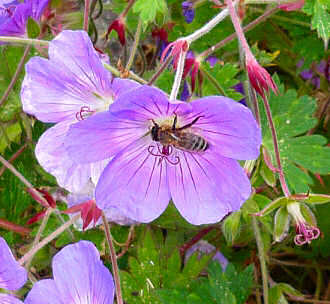Bees begin the process of making honey by collecting nectar – a sugary juice that is in the head of flowers. The worker bee is usually around 20 days old when it begins the job of collecting nectar and she covers hundreds of plants in a short space of time.
The worker bee collects nectar in the centre of the flower, during this process the pollen on the bee’s body rubs off on the flower and this helps pollination tremendously. In fact, bees are the most prolific pollinators in nature. The worker bee works so hard at collecting nectar during the summer months that it unfortunately dies after about 5 to 6 weeks from pure exhaustion.
The honey bee collects the nectar with their long tongues (known as glossa). They store the sugary nectar in their honey stomach, and it then mixes with enzymes from the hypopharyngeal gland within the bee’s body. Once full they return to the hive and transfer the sugary substance, by mouth, to another bee whose job it is to store the product. This bee is between 6 to 18 days old and their job is to process honey in the hive.
This bee then transfers the substance into the hexagonal wax comb cells and the bees continue to fill the comb cells until they are full. Bees keep the temperature inside the hive relatively constant between 32.5°C and 35°C. Maintaining this temperature helps the evaporation of water inside the honey substance.
The bees also use enzymes with the sugary nectar and this helps the process by breaking complex sugars down into glucose and fructose. Once the bees are happy that the water has evaporated sufficiently, they seal the comb cell by capping it with wax. The water is usually evaporated until the nectar is about 17% to 18% water.
The honey produced is then stored until the bees need to eat it, they naturally store food sources to enable them to eat during the winter or times of bad weather. The beekeeper removes excess stores and it is the beekeepers responsibility to ensure the bees are fed during the winter and during bad spells of weather by replacing the harvested honey.
Different types of honey are available depending on the type desired and these require different processes. For creamed honey a soft beating is required and for clear honey a gentle heating is required. It is recommended that the honey is not heated over 60°C because it can affect the quality and the health benefits of honey. Cut comb is the honey comb cut out directly from the frame whilst the honey is still capped and sealed with wax. This is a popular choice because it contains the wax and honey combined and so is thought to have better health benefits.

Some bees can be surrounded by a particular plant which can account for some types of honey being sold as a particular plant type.
An average honey will contain approximately 17% water, 31% fructose, 38% glucose, 1% sucrose, 9% other sugars and about 4% organic acids and other substances.
Copyright © Cornwall Honey
